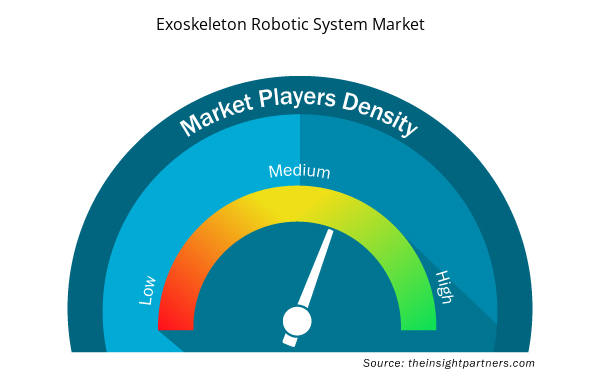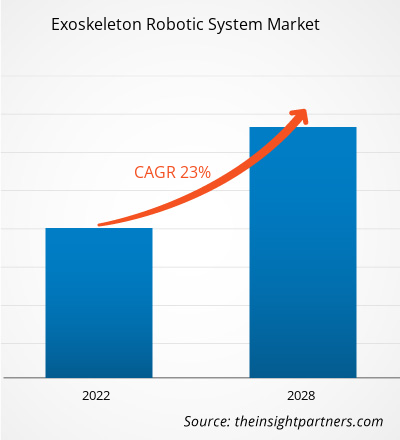外骨骼机器人系统市场预计将从 2021 年的 10.0114 亿美元增长到 2028 年的 42.2463 亿美元;预计 2022 年至 2028 年的复合年增长率为 23.0%。
外骨骼机器人系统是一种人机协作系统。机器人外骨骼被视为可穿戴机器人装置,由计算机板控制,为电机、气动装置、杠杆或液压系统提供动力,以恢复运动能力。由于中风和肌肉骨骼疾病发病率上升,以及市场参与者的战略举措不断增加,外骨骼机器人系统市场正在增长。
市场洞察
中风和肌肉骨骼疾病发病率上升推动市场增长
尽管医疗行业取得了长足进步,但中风仍然是公众健康的主要关注疾病。据印度中风协会称,过去几十年来,印度中风的发病率增加了约 100%。此外,印度每年约有 180 万人患中风,只有及早治疗才能降低发病率和死亡率。尽管这种非传染性疾病的发病率不断上升,威胁着更多的人口,但该国的中风治疗和康复仍然不发达。根据疾病控制和预防中心的数据,每年美国有超过 795,000 人中风,其中约 610,000 人是首次或新发中风。此外,中风是美国第五大死亡原因,2018 年导致 147,810 人死亡。总体而言,2019 年美国估计有 460,000 例中风(三分之二为缺血性中风),190,000 例中风相关死亡,中风伤残调整生命年为 383 万年。因此,中风发病率的上升增加了对外骨骼机器人系统的需求,用于中风患者的康复,以帮助改善生活质量。
此外,肌肉骨骼疾病会影响个人的活动能力。肌腱炎、肌肉减少症、骨质减少症和下背部损伤等肌肉骨骼疾病的患病率不断上升,预计将推动对外骨骼机器人系统的需求。根据世界卫生组织 (WHO) 的数据,全球约有 17.1 亿人患有肌肉骨骼疾病,下背部疼痛是 160 个国家/地区致残的主要原因。这些外骨骼机器人系统可帮助患者管理病情并恢复活动能力,从而改善他们的整体生活质量。因此,中风和肌肉骨骼疾病的患病率不断上升,推动了外骨骼机器人系统在康复中的应用。
定制此报告以满足您的需求
您可以免费定制任何报告,包括本报告的部分内容、国家级分析、Excel 数据包,以及为初创企业和大学提供优惠和折扣
- 获取此报告的关键市场趋势。这个免费样品将包括数据分析,从市场趋势到估计和预测。
技术进步日新月异,投资不断增加
由于技术不断发展和创新,医疗服务和护理质量不断提高,医疗行业趋势正在发生巨大变化。全球外骨骼机器人系统市场的各种参与者都在努力争取更大的市场份额,随后全球对外骨骼机器人系统的投资不断增加。例如,2022 年 4 月,外骨骼制造商 RoboCT 技术开发有限公司完成了 1570 万美元(人民币 1 亿元)的 A+ 轮融资。总部位于中国杭州的 RoboCT 为残疾人、老年人和医疗康复机构提供智能康复设备和具有数据分析和云计算的机器人技术。此外,这些公司研发活动的激增预计将加速为医疗保健、化学、国防和商业等不同应用领域开发先进系统。这些公司还拥有自己的技术和知识产权 (IPR),这有助于他们保持市场份额。例如,北京赛特科技发展有限公司致力于外骨骼技术的研发,涉及娱乐、工业、体育等多个领域,已申请知识产权100余项,并获得了20多个领域的奖项。
此外,持续的技术进步有望促进市场增长。人工智能 (AI) 和物联网 (IoT) 在开发智能外骨骼机器人系统中的日益普及预计将促进市场增长。例如,德国 Bionic 开发了一种基于人工智能的外骨骼机器人系统,该系统增加了智能安全伴侣和基于云的外骨骼平台。因此,不断的技术进步和不断增加的投资可能会催化全球外骨骼机器人系统市场的增长
基于类型的洞察
根据类型,外骨骼机器人系统市场分为下肢外骨骼、上肢外骨骼和全身外骨骼。下肢外骨骼部分在 2021 年占据外骨骼机器人系统市场的最大市场份额,而上肢外骨骼部分很可能成为预测期内增长最快的部分。
基于类型的洞察
根据类型,外骨骼机器人系统市场分为下肢外骨骼、上肢外骨骼和全身外骨骼。下肢外骨骼部分在 2021 年占据了最大的市场份额。预计上肢外骨骼部分在预测期内的复合年增长率最高,为 23.6%。
基于应用的洞察
根据应用,外骨骼机器人系统市场细分为医疗保健、国防和工业。医疗保健领域在 2021 年占据了最大的市场份额。工业领域预计在预测期内将实现最高的复合年增长率,为 23.6%。
外骨骼机器人系统市场中的公司大量采用并购等无机和有机策略。以下列出了近期的主要市场发展:
- 2022 年 2 月,Hocoma 宣布 SwissNeuroRehab 旗舰项目将获得瑞士创新机构 Innosuisse 的资助。SwissNeuroRehab 项目旨在开发和评估一种从医院到家庭的全程护理的新型神经康复模式,结合最佳的数字和技术方法,根据患者的个性化需求量身定制创新而高效的治疗方案。
- 2021 年 11 月,FDA 授予 ReWalk ReBoot Soft Exo-Suit 突破性设备称号,用于家庭中风康复。ReBoot 是一款轻便的电池供电矫形外骨骼,旨在帮助因神经损伤和中风而踝关节功能下降的个人进行行走功能。它是 ReStore 设备的姊妹产品,ReStore 设备于 2019 年获得 FDA 批准用于康复环境。
外骨骼机器人系统市场区域洞察
Insight Partners 的分析师已详尽解释了预测期内影响外骨骼机器人系统市场的区域趋势和因素。本节还讨论了北美、欧洲、亚太地区、中东和非洲以及南美和中美洲的外骨骼机器人系统市场细分和地理位置。

- 获取外骨骼机器人系统市场的区域特定数据
外骨骼机器人系统市场报告范围
| 报告属性 | 细节 |
|---|---|
| 2021 年市场规模 | 10亿美元 |
| 2028 年市场规模 | 42.2亿美元 |
| 全球复合年增长率(2021 - 2028) | 23.0% |
| 史料 | 2019-2020 |
| 预测期 | 2022-2028 |
| 涵盖的领域 | 按类型
|
| 覆盖地区和国家 | 北美
|
| 市场领导者和主要公司简介 |
|
外骨骼机器人系统市场参与者密度:了解其对业务动态的影响
外骨骼机器人系统市场正在快速增长,这得益于终端用户需求的不断增长,而这些需求又源于消费者偏好的不断变化、技术进步以及对产品优势的认识不断提高等因素。随着需求的增加,企业正在扩大其产品范围,进行创新以满足消费者的需求,并利用新兴趋势,从而进一步推动市场增长。
市场参与者密度是指在特定市场或行业内运营的企业或公司的分布情况。它表明在给定市场空间中,相对于其规模或总市场价值,有多少竞争对手(市场参与者)存在。
在外骨骼机器人系统市场运营的主要公司有:
- 洛克希德·马丁公司
- 赛博达因公司
- 松下控股公司
- 霍科马公司
- ReWalk 机器人公司
免责声明:上面列出的公司没有按照任何特定顺序排列。

- 了解外骨骼机器人系统市场顶级关键参与者概览
公司简介 - 外骨骼机器人系统市场
- 洛克希德·马丁公司
- 赛博达因公司
- 松下控股公司
- 霍科马公司
- Rewalk机器人公司
- Ekso Bionics 控股公司
- 派克汉尼汾公司
- Myomo公司
- B-Temia 公司
- AlterG 公司
- 英诺菲斯有限公司
- 历史分析(2 年)、基准年、预测(7 年)及复合年增长率
- PEST 和 SWOT 分析
- 市场规模价值/数量 - 全球、区域、国家
- 行业和竞争格局
- Excel 数据集



Report Coverage
Revenue forecast, Company Analysis, Industry landscape, Growth factors, and Trends

Segment Covered
This text is related
to segments covered.

Regional Scope
North America, Europe, Asia Pacific, Middle East & Africa, South & Central America

Country Scope
This text is related
to country scope.
常见问题
Global exoskeleton robotic system market is segmented by region into North America, Europe, Asia Pacific, the Middle East & Africa, and South & Central America. North America is likely to continue its dominance in the exoskeleton robotic system market during 2022–2028. The US holds the largest share of the market in North America and is expected to continue this trend during the forecast period.
Companies operating in the market are Lockheed Martin Corp; Cyberdyne Inc; Panasonic Holdings Corp; Hocoma AG; Rewalk Robotics Inc; Ekso Bionics Holdings Inc; Parker Hannifin Corp; Myomo Inc; B-Temia Inc; AlterG Inc; INNOPHYS Co., LTD. amongst others.
Based on application, the exoskeleton robotic system market is segmented into healthcare, defense, and industrial. The healthcare segment accounted for the largest share of the market in 2021.
The market for exoskeleton robotic systems is growing due to rising incidence of stroke & musculoskeletal disorders and increasing strategic initiatives by market players.
The exoskeleton robotic system market, based on type, is segmented into lower body exoskeleton, upper body exoskeleton, and full body exoskeleton. The lower body exoskeleton segment held the largest market share of the exoskeleton robotic system market in 2021 and upper body exoskeleton segment is likely to be the fastest-growing segment during the forecast period.
The exoskeleton robot system is a type of human–robot cooperation system. Robotic exoskeletons are considered wearable robotic units controlled by computer boards to power a system of motors, pneumatics, levers, or hydraulics to restore locomotion. The market for exoskeleton robotic systems is growing due to rising incidence of stroke & musculoskeletal disorders and increasing strategic initiatives by market players.
Trends and growth analysis reports related to Life Sciences : READ MORE..
The List of Companies - Exoskeleton Robotic System Market
- Lockheed Martin Corp
- Cyberdyne Inc
- Panasonic Holdings Corp
- Hocoma AG
- ReWalk Robotics Inc
- Ekso Bionics Holdings Inc
- Parker Hannifin Corp
- Myomo Inc
- B-Temia Inc
- AlterG Inc
- INNOPHYS CO., LTD.
The Insight Partners performs research in 4 major stages: Data Collection & Secondary Research, Primary Research, Data Analysis and Data Triangulation & Final Review.
- Data Collection and Secondary Research:
As a market research and consulting firm operating from a decade, we have published and advised several client across the globe. First step for any study will start with an assessment of currently available data and insights from existing reports. Further, historical and current market information is collected from Investor Presentations, Annual Reports, SEC Filings, etc., and other information related to company’s performance and market positioning are gathered from Paid Databases (Factiva, Hoovers, and Reuters) and various other publications available in public domain.
Several associations trade associates, technical forums, institutes, societies and organization are accessed to gain technical as well as market related insights through their publications such as research papers, blogs and press releases related to the studies are referred to get cues about the market. Further, white papers, journals, magazines, and other news articles published in last 3 years are scrutinized and analyzed to understand the current market trends.
- Primary Research:
The primarily interview analysis comprise of data obtained from industry participants interview and answers to survey questions gathered by in-house primary team.
For primary research, interviews are conducted with industry experts/CEOs/Marketing Managers/VPs/Subject Matter Experts from both demand and supply side to get a 360-degree view of the market. The primary team conducts several interviews based on the complexity of the markets to understand the various market trends and dynamics which makes research more credible and precise.
A typical research interview fulfils the following functions:
- Provides first-hand information on the market size, market trends, growth trends, competitive landscape, and outlook
- Validates and strengthens in-house secondary research findings
- Develops the analysis team’s expertise and market understanding
Primary research involves email interactions and telephone interviews for each market, category, segment, and sub-segment across geographies. The participants who typically take part in such a process include, but are not limited to:
- Industry participants: VPs, business development managers, market intelligence managers and national sales managers
- Outside experts: Valuation experts, research analysts and key opinion leaders specializing in the electronics and semiconductor industry.
Below is the breakup of our primary respondents by company, designation, and region:

Once we receive the confirmation from primary research sources or primary respondents, we finalize the base year market estimation and forecast the data as per the macroeconomic and microeconomic factors assessed during data collection.
- Data Analysis:
Once data is validated through both secondary as well as primary respondents, we finalize the market estimations by hypothesis formulation and factor analysis at regional and country level.
- Macro-Economic Factor Analysis:
We analyse macroeconomic indicators such the gross domestic product (GDP), increase in the demand for goods and services across industries, technological advancement, regional economic growth, governmental policies, the influence of COVID-19, PEST analysis, and other aspects. This analysis aids in setting benchmarks for various nations/regions and approximating market splits. Additionally, the general trend of the aforementioned components aid in determining the market's development possibilities.
- Country Level Data:
Various factors that are especially aligned to the country are taken into account to determine the market size for a certain area and country, including the presence of vendors, such as headquarters and offices, the country's GDP, demand patterns, and industry growth. To comprehend the market dynamics for the nation, a number of growth variables, inhibitors, application areas, and current market trends are researched. The aforementioned elements aid in determining the country's overall market's growth potential.
- Company Profile:
The “Table of Contents” is formulated by listing and analyzing more than 25 - 30 companies operating in the market ecosystem across geographies. However, we profile only 10 companies as a standard practice in our syndicate reports. These 10 companies comprise leading, emerging, and regional players. Nonetheless, our analysis is not restricted to the 10 listed companies, we also analyze other companies present in the market to develop a holistic view and understand the prevailing trends. The “Company Profiles” section in the report covers key facts, business description, products & services, financial information, SWOT analysis, and key developments. The financial information presented is extracted from the annual reports and official documents of the publicly listed companies. Upon collecting the information for the sections of respective companies, we verify them via various primary sources and then compile the data in respective company profiles. The company level information helps us in deriving the base number as well as in forecasting the market size.
- Developing Base Number:
Aggregation of sales statistics (2020-2022) and macro-economic factor, and other secondary and primary research insights are utilized to arrive at base number and related market shares for 2022. The data gaps are identified in this step and relevant market data is analyzed, collected from paid primary interviews or databases. On finalizing the base year market size, forecasts are developed on the basis of macro-economic, industry and market growth factors and company level analysis.
- Data Triangulation and Final Review:
The market findings and base year market size calculations are validated from supply as well as demand side. Demand side validations are based on macro-economic factor analysis and benchmarks for respective regions and countries. In case of supply side validations, revenues of major companies are estimated (in case not available) based on industry benchmark, approximate number of employees, product portfolio, and primary interviews revenues are gathered. Further revenue from target product/service segment is assessed to avoid overshooting of market statistics. In case of heavy deviations between supply and demand side values, all thes steps are repeated to achieve synchronization.
We follow an iterative model, wherein we share our research findings with Subject Matter Experts (SME’s) and Key Opinion Leaders (KOLs) until consensus view of the market is not formulated – this model negates any drastic deviation in the opinions of experts. Only validated and universally acceptable research findings are quoted in our reports.
We have important check points that we use to validate our research findings – which we call – data triangulation, where we validate the information, we generate from secondary sources with primary interviews and then we re-validate with our internal data bases and Subject matter experts. This comprehensive model enables us to deliver high quality, reliable data in shortest possible time.


 获取此报告的免费样本
获取此报告的免费样本